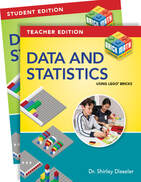 Happy Spring! No April Fooling from us today -- it's time for a new FREE Brick Math Lesson of the Month! This lesson comes from Data and Statistics, which is part of the extension of the Brick Math curriculum into 7th-8th grade math subjects. It shows how to use bricks to model bar graphs and histograms, and maybe most importantly, to understand when to use the different types of graphs depending on the type of data. To get the April 2024 Brick Math Lesson of the Month, "Bar Graphs and Histograms" plus a new lesson each month, click here. Each Lesson of the Month includes the Teacher Lesson Guide as well as the Student Workbook Pages that correspond to the lesson.  This lesson really uses the bricks well to help students learn how to construct bar graphs and histograms when given a set of data. It reinforces a key piece of information about building graphs: that bar graphs are uses for discrete data and histograms are used for continuous data. Building graphs out of bricks and then drawing those graphs is part of the learning process that gives students confidence in their ability to represent data in graphical form.  Data and Statistics and Pre-Algebra bring the Brick Math curriculum into 7th and 8th grade math. The topics are perfect for middle school students who are learning the topics for the first time, or for students who need some help learning because a more traditional curriculum has failed them. Brick Math is a complete math curriculum for kindergarten through 8th grade that models the math with bricks. The curriculum is divided into 13 separate content areas: Counting, Addition, Subtraction, Multiplication, Division, Basic Fractions, Basic Measurement, Fraction Multiplication, Fraction Division, Advanced Measurement and Geometry, Decimals, Data and Statistics, and Pre-Algebra. Students can start anywhere in the curriculum. It can be used as a complete math curriculum or brought in as a supplement to help students who aren't having math success with other programs. Brick Math works in many applications: for homeschooling, math intervention, enrichment, and as a whole-school program. Materials are simple and affordable.
For an innovative way to teach and learn K-8th grade math, check brickmath.com. The website includes videos for both teacher training and direct instruction of students. You can learn more about how Brick Math improves students' math test scores and hear what people who are using Brick Math have to say about the program.
0 Comments
 Brick Math is proud to announce our brand-new 7th - 8th grade content with two new subjects added to the curriculum: Pre-Algebra and Data and Statistics. As with all the Brick Math curriculum, the content is taught by modeling the math with LEGO® or LEGO®-compatible bricks, giving students a hands-on experience that helps them gain deep understanding of the mathematical concepts. Each subject has a Teacher Edition that guides the teacher through the step-by-step lessons as well as a Student Edition that is a workbook for students to draw their brick models and includes student assessments for every chapter. The Brick Math brick set works for these new subjects, too.  The new content extends Brick Math to a complete K - 8 curriculum solution for schools as well as for homeschooling. Brick Math is ideally suited for students who haven’t been able to learn the concepts through more traditional methods.  In Pre-Algebra, students are introduced to topics that help them prepare for high school math. These include integers, fractions, square roots, step equations, linear equations, and decimals. Students learn how to solve basic equations using variables. Modeling with bricks, students engage in problem-solving activities that expand their knowledge of: • absolute value and positive/negative numbers • exponents, including negative exponents and multiplicative inverse • rules of integers • algebraic expressions • equations and inequalities • slope  In Data and Statistics, students learn the basics of representing and interpreting data with line plots, bar graphs, histograms, and box plots. They learn how to measure central tendency through mean, median, mode, and range. Then students move on to learn about coordinates, line graphs, and scatter plots. Finally, they learn how to graph and calculate the slope of a line. The final chapter is an introduction to both theoretical and experimental probability. Modeling with bricks, students engage in problem-solving activities that expand their knowledge of: • visual models and graphs of data sets • measures of central tendency • coordinate grids • slope • theoretical and experimental probability Both books progress through these topics in modules, moving from more basic to more complex in each chapter. Most students learn these Pre-Algebra and Data and Statistics topics in grades 7 - 8. We have had so many requests to extend the Brick Math program through eighth grade, and it’s finally here! We’re excited to share the new Brick Math content with you. Brick Math is a K-8 math curriculum that uses LEGO® bricks to model 13 different math subjects:
Counting, Addition, Subtraction, Multiplication, Division, Basic Fractions, Basic Measurement, Fraction Multiplication, Fraction Division, Advanced Measurement and Geometry, Decimals, Data and Statistics, and Pre-Algebra. Brick Math works in many applications: for homeschooling, math intervention, enrichment, and as a whole-school program. Materials are simple and affordable. If you are a math teacher or a parent with a student at home who is learning K-8th grade math, check brickmath.com. The website includes videos for both teacher training and direct instruction of students. You can learn more about how Brick Math improves students' math test scores and hear what people who are using Brick Math have to say about the program. |
Categories
All
Archives
July 2024
|


